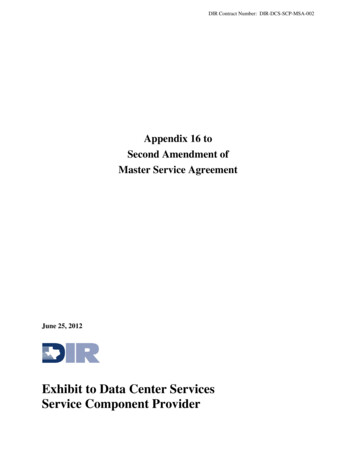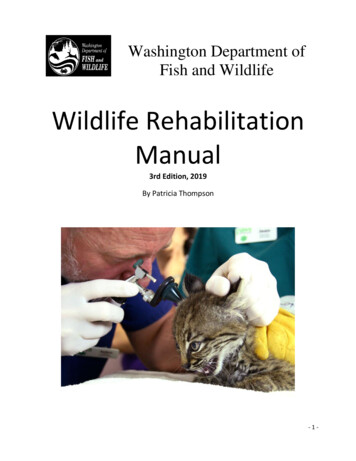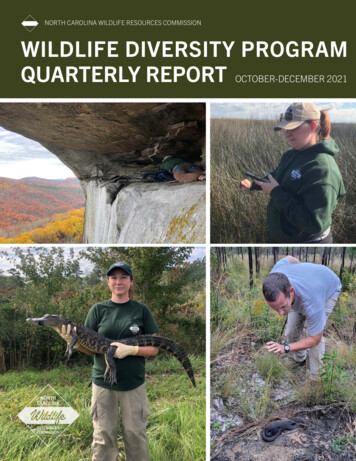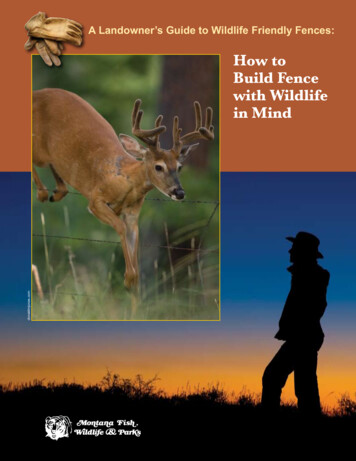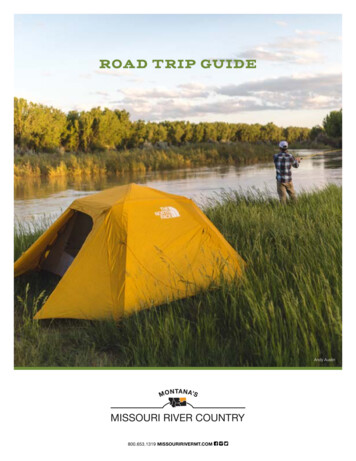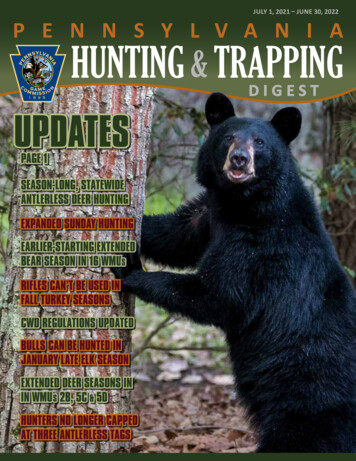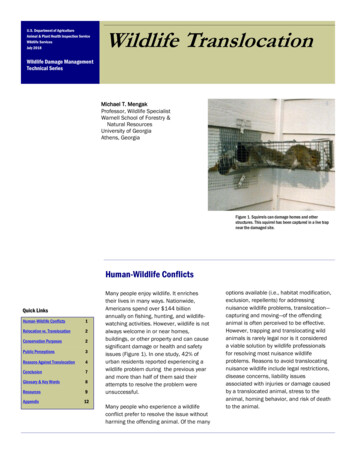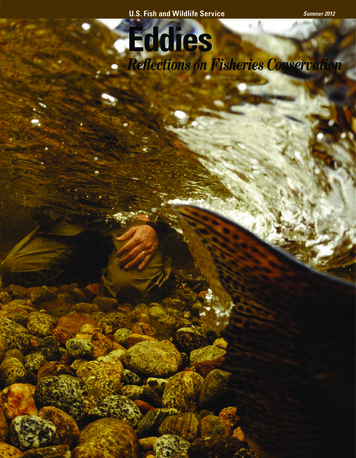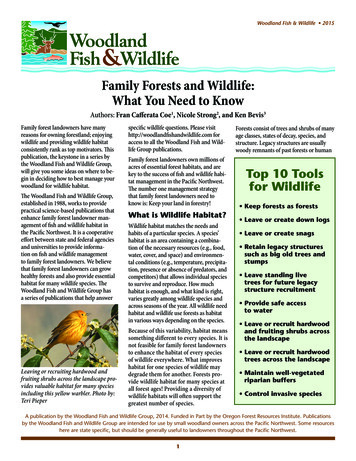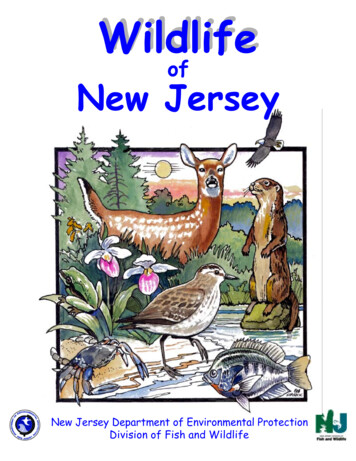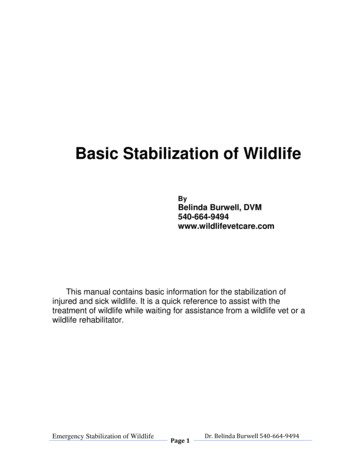
Transcription
Basic Stabilization of WildlifeByBelinda Burwell, DVM540-664-9494www.wildlifevetcare.comThis manual contains basic information for the stabilization ofinjured and sick wildlife. It is a quick reference to assist with thetreatment of wildlife while waiting for assistance from a wildlife vet or awildlife rehabilitator.Emergency Stabilization of WildlifePage 1Dr. Belinda Burwell 540-664-9494
Remember, you must have a permit from the Virginia Department of Game andInland Fisheries to keep and rehabilitate wildlife (804-367-9588). Veterinarians withoutpermits are allowed to treat these animals when needed, but then must turn the animal overto an individual permitted to rehabilitate that species. To care for any bird species otherthan a pigeon, starling or sparrow, a permit must be obtained from the U.S. Fish andWildlife Service (413-253-8643). Wildlife Rehabilitation is not allowed in West Virginia.It is very important to remember to get as much information as possible from the finderof the animal, such as where the animal was found and who touched it. This information isneeded by the health department if there is a possible rabies exposure. The Department ofGame and Inland Fisheries requires wildlife rehabilitators to know where animals werefound because some species must be released back where they were found or they musteuthanized to decrease the risk of them carrying a disease to a new area. Informationacquired from the finder of the animal can give clues as to what may have happened to theanimal and what treatment may be needed. (Attached is a sample form for the finder to fillout).The most important thing to remember when handling wildlife is Less is Best.Less handling.Less noise.Less light.Less stimulation in general.And less drugs Especially steroids. Studies have shown that survival rates in raptors arehigher if they are not given steroids. It is now recommended that steroids never be given,even if the birds have head trauma. There is no proof they do any good, and we now knowthey decrease survival by increasing susceptibility to infections like aspergillus.The only thing these animals usually need more of is heat and fluids. Keep them warm,especially the reptiles. Rehydration and heat are usually the most helpful things we can dofor these animals.If the animal is stable, you don’t need to do anything but keep them in adark, quiet, and warm environment until a rehabilitator arrives.If you do treat them, please write down what you do and give thisinformation to the rehabilitator who picks up the animal.Emergency Stabilization of WildlifePage 2Dr. Belinda Burwell 540-664-9494
Please do not feed these animals.Feeding wildlife the wrong foods can cause severe GI distress, making what is already abad situation much worse for the animal. Only give food when it has been recommendedby a wildlife rehabilitator who is knowledgeable with that species.Feeding an animal that is cold, dehydrated, in shock, or in a state of starvation can makethem sick because they will not be able to digest the food and instead that food willdecompose and ferment in their GI tract.Rescued animals need to be warmed and rehydrated before putting anything into theirGI tract. After that, oral feeding should be started with electrolyte solutions only. Foodshould not be given until you are sure the GI tract is functional. Putting food into a nonfunctional GI tract (with ileus) will cause the food to sit and spoil inside the animal and cancause death.*Remember wildlife can carry zoonotic diseases. Always wear gloves!*Always remember their weapons – teeth, claws, beaks or talons. Be careful!*Any raccoon, fox, skunk, bat, or groundhog who bites a person or pet will need to betested for rabies. In all cases where a wild mammal has bitten a person or pet, contactyour County Health Department for advice.PHYSICAL EXAMFirst give the animal a quick superficial exam. Determine if there are life threateningproblems such as breathing difficulties, profuse bleeding, or head trauma. If not, thencheck for wounds, external parasites, possible fractures, and dehydration. Get a weight ingm or kg. If you have life threatening problems, take care of these before worrying aboutother things like treating external parasites or cleaning wounds.Then put the animal in a dark quiet box or cage to rest while you gather materialsneeded for treatment, i.e. wound lavage solution, SQ fluids, antibiotics, pain meds, orbandage materials. Set up for radiographs, anesthesia, and suturing if needed.Have everything prepared before you take the animal out again. Use proper restraint,cover their eyes with a towel to decrease stimulation, and minimize noise. Give anesthesiaif needed. Gas anesthesia can be very useful for restraining birds. Work quickly andquietly, then put the animal away in a dark quiet place. Try to keep the animal where itcannot hear or see people or dogs and cats. Resist the urge to show them to everyone.Excess stress can be more deadly to these animals than their injuriesEMERGENCIESBreathing problems: Put in an oxygen cage. Do not try to restrain in an oxygen mask,this is too stressful for a wild animal.Profuse bleeding: Pressure, wrap, add to bandage rather than changing soaked bandage.Severe blood loss: IV or IO fluids (If you are interested Dr. Burwell can teach yourhospital how and where to give this to wildlife)Emergency Stabilization of WildlifePage 3Dr. Belinda Burwell 540-664-9494
Head trauma: Minimize stress and handling. Treat with metacam. Place in a dark quietarea. If recumbent, keep head elevated. Do not scruff or grab around the neck because thiscan increase brain swelling. Do not give anything orally to an unconscious or dementedanimal.SONGBIRDSDisoriented due to head trauma (i.e. hit a window):Put in a small box or a closed brown paper bag in a dark, quiet, warm area and wait 1 hour.Keep head elevated if they are recumbentMost of these birds will come to their senses in an hour or so. Less stimulation is bestfor them.If they can swallow you can give a very small oral dose of metacam (0.2-0.5 mg/kg).Do not give water to drink until they are awake and able to stand. Do not force feed.Wounds:Lavage with sterile IV fluidsCover with tegaderm, do not use oily topical antibiotics which will damage thefeathers. Wound hydrogels work well.Start antibiotics – Clavamox or Baytril (dosages below)Attacked by cats or dogs: Even if you cannot find a wound assume the skin may havebeen punctured somewhere and start antibiotics immediately. These infectionswill be deadly within 72 hours if antibiotics are not started right away. (Clavamoxat 125 mg/kg BID)Fractures:Wings- stabilize with a wing wrap (see diagrams 1 & 2)Legs- stabilize with a tape splint or wrap to body (see diagram 3 & 4)If they have open fractures or have any other wounds, start antibiotics.Baby birds: Keep warm at 80-90 degrees using a heat lamp or warm water in a rubberglove reheated in microwave. Monitor temperature.Place bird in a small bowl or cup lined with Kleenex or paper towels.FLUIDS FOR BIRDS:Maintenance fluid requirements (see chart 1 for a quick way to calculate volume)Baby birds : 100-150 ml/kg/day divided 3-6 times a day PO or SQAdults : 50 ml/kg/day deficitsOral Fluids: Must be given by gavage tube feeding. Do not squirt fluids into a bird’sEmergency Stabilization of WildlifePage 4Dr. Belinda Burwell 540-664-9494
mouth because they may aspirate the fluid into their lungs. Warm oral or SQ fluids beforeadministration.Baby birds: Give 2-5 ml /100 gms BW PO. Start with lesser amount. Warm fluids.Repeat every 2-4 hours as needed.Adults : Give 2-4 ml/100 gm PO. Start with the lower amount to prevent aspirationSQ fluidsGive warm SQ fluids over the back between scapulas or in the inguinal area where theleg meets the body. Do not give dorsally at base of neck because there are airsacs there.Volume: Give only as much as possible without making the skin excessively taught. Afterwithdrawing the needle apply pressure over puncture site to prevent leakage.Antibiotic Dosages for BirdsClavamox 125 mg/kg PO q 12 hoursAmoxi 100 mg/kg PO q 8 hoursTrimethoprim/Sulfamethoxazole 10-50 mg/kg PO q 24 hoursBaytril 10-20 mg/kg PO, SC, IM q12-24 hours (dilute if giving SQ or IM)Clindamycin 100 mg/kg PO q 24 hoursEmergency Stabilization of WildlifePage 5Dr. Belinda Burwell 540-664-9494
Analgesia:Metacam 0.2-0.5 mg/kg first dose then 0.2 mg/kg BIDFor suspected toxicity:Toxiban 1-2 ml /100 gmAtropine 0.2 mg/kg IM q 3-4 hours for cholinesterase toxicityWaterfowl: Ducks and GeeseIf suspect botulism or other toxicity and can hold head up, give Toxiban 10-20 ml/kg POGive supportive care of SQ and oral fluids if holding head up.RaptorsHead trauma:Put in a dark quiet place to rest. Give metacam 0.5 mg/kg for the first dose then 0.2 mg/kgBID. Please do not give steroids.Topical ophthalmic NSAIDS are helpful with eye trauma (hyphema, retinal detachment)Owls frequently have eye injuries. Common injuries are retinal tears and detachments. Ifonly one eye is affected, the owl should recover enough sight to be released again.Wounds:Use gas anesthesia if needed and the bird is stableLavage wounds with sterile saline. Keep patient warm.Torn skin can be replaced over clean wounds and taped in place for suturing later.Plucking feathers around the edges of a laceration can tear the skin further. Instead cutthe feathers or just wet them down and push out of the way.Apply tegaderm over open wounds.Do apply any ointments to wounds that are going to be sutured closed.Start systemic antibiotics.Broken bones:Use gas anesthesia to get radiographs if the bird is stable.If the patient is unstable don’t stress them with radiographs.Wing fractures: If distal to elbow use a figure 8 wrap (see diagram 1)If fracture is in the elbow, humerus, or shoulder, apply a figure 8 wrap andwrap the wing to the body, or just wrap whole wing to body. (see diagram 2)Leg Fractures: If you splint the leg, the splint must immobilize the joint above and thejoint below the fracture. Be sure the leg splint does not cause the leg to twistabnormally. Another way to take pressure off the fracture is to suspend the bird in abox with packing peanuts or shredded paper which keeps their weight off the leg.Start pain meds: Metacam and butorphanolStart antibiotics if the fracture is open: Baytril or ClindamycinEmergency Stabilization of WildlifePage 6Dr. Belinda Burwell 540-664-9494
Eye injuries:Hyphema: Treat with NSAID ophthalmic dropsMetacam oral or injection if hydration status good and not in shockDehydrationWarm SQ fluids given over back behind scapulas or inguinal area where leg meets bodyVolume: Only give an amount that does not make the skin excessively taught.Fluid requirements: Daily maintenance 50 ml/kg deficits lossesAntibioticsBaytril 15 mg/kg PO, SC, IM q 24 hours (dilute if giving SC or IM)Ceftazidime 50-100 mg/kg IM, IV q 4-8 hoursCetiofur 50-100 mg/kg q 4-8 hoursTrimethoprim/Sulfamethoxazole 48 mg/kg PO q 24 hoursClindamycin (for open fractures) 100-150mg/kg q 24 hoursNSAIDSMeloxicam 0.5 mg/kg PO or IM first dose then give 0.2-0.4 mg/kg BID. Make sure theyare hydrated.Pain medsButorphanol 0.3-0.5 mg/kg IM q 12 hoursMisc MedsActivated Charcoal: Toxiban 10-20 ml/kg POAtropine for cholinesterase inhibitor toxicity: 0.1 mg/kg q 3-4 hoursVitamin K1 for rodenticide poisoning 2.5 mg/kg IM q 24 hours for 14 daysMammalsKnow your rabies vector species: Skunks, Raccoons, Foxes, and Bats.Groundhogs can contract rabies from raccoons, foxes, and skunks that share theirborrows. (Remember any mammal, even opossums, can contract rabies).It is extremely important to get contact information from the finder of these animalsin case the animal is found to be rabid. Contact information should be taken from allgood Samaritans who bring in wildlife. If any of these species bit or scratched ahuman or pet, contact your local Health Department for advice. (This applies even isthe person or pet is currently vaccinated for rabies)Do not let anyone who is not vaccinated for rabies touch these species.Always wear gloves.Orphan baby mammalsRewarm: Use water bottles or heat lamp. Keep at 80-90 degrees. Watch temp: babies canoverheat if they can’t move away from the heat source.Emergency Stabilization of WildlifePage 7Dr. Belinda Burwell 540-664-9494
Rehydrate SQ: 80-100 ml/kg divided into three doses daily (see chart 1 for a quick way tocalculate volume)If hydrated and warm you can start oral electroytes (Pedialyte)Do not immediately start formula. If the baby is cold or dehydrated, feeding it can causemore harm than good. Also, giving the wrong formula can cause problems. Each speciesof orphan needs a different formula. If you have fed them the wrong formula and therehabilitator has to switch them to the correct formula, this change can cause diarrheawhich is stressful and sometimes fatal to these babies.Once the baby is warm and rehydrated, oral electrolytes are given before any formula isstarted. Pedialyte is a good oral electrolyte solution for use in baby mammals.Volume per feeding: 5% BW in grams (for 100 gm give .05 X 100 5 ml).Stimulate to urinate and defecate at every feeding. Feed every about every 3 hours.Attacks by cats or dogs: Always start amoxi or clavamox immediately (except incottontails)Dose at usual mammal dosagesAdult mammalsTreat similarly to catsAnesthesia may be needed for treatment.The ketamine, medetomidine, butorphanol combination works well at the cat dosage forraccoons, foxes, opossums, skunks.Bunnies with torn skin or degloving injuries:Lavage the area with sterile saline, Do not try to clip the hair (this is impossible and verystressful to the rabbit) Never apply disinfectant solutions or oily topicalmedications to fresh wounds since this will interfere with primary healingGlue the skin back over the clean wound at the skin edges with Tissuemend II – this isan absorbable glue so it doesn’t matter if some gets under the skin.Start Baytril or Trimeth/Sulfa (dosages below)Antibiotic dosages for mammals:Baytril 5 mg/kg PO, SQ, IM q 12-24 hoursAmoxi 22 mg/kg PO, SQ q 12 hoursClavamox 13.75 mg/kg PO q 12 hoursTrimethoprim/Sulfamethoxazole 30 mg/kg PO q12 hoursDo not use oral Amoxi or Clavamox in rabbits and rodentsPain MedicationMeloxicam 0.1-0.2 mg/kg q 24 hoursBuprenex 0.01-0.03 mg/kg (higher in rodents)AnxiolyticsMidazolam 0.3-1.0 mg/kg IM or SQEmergency Stabilization of WildlifePage 8Dr. Belinda Burwell 540-664-9494
AnesthesiaFor healthy aggressive fox, raccoon, skunk, opossum: Combine Butorphanol 0.45 mg/kg, Dexdormitor 0.045 mg/kg, Ketamine 4.5 mg/kg IMDepending on the condition of the animal, decrease the dosages. Use pain control.Rabbits, groundhogs, squirrels: Midazolam 1-2 mg/kg then mask with sevo or isoUse pain control Buprenex .05-.1 mg/kgBeaver: Dexdormitor 0.03 mg/kg Ketamine 3-4 mg/kg IMDeerCurrently, adult deer (older than 6 mos) are not allowed to be rehabilitated in Virginia.Adult deer with fractures are rarely successfully rehabilitated. They do not toleratecaptivity and euthanasia is usually required.Fawns: Before beginning treatment, make sure you have a rehabilitator who will take thisfawn. Some rehabbers are so overwhelmed with caring for a large number of healthyorphans and cannot take fawns with injuries or fractures. Raising fawns requires a lot ofmoney, space, and time.Because of concerns for the spread of Chronic Wasting Disease, orphan or injuredfawns found within the Containment Area in Frederick, Clarke, Warren, andShenandoah Counties are not allowed to be rehabilitated and are required by DGIFto be euthanized. Contact DGIF for more information. The Virginia Department ofGame and Inland Fisheries (DGIF) has strict rules regarding the movement of deer or deerparts in the Containment Area. Stay educated about the current status of CWD and theContainment Area in Virginia. DGIF is changing its rules regarding the movement of deeras this disease spreads.Please remember when caring for wild mammals: It is important not to let these animalsbecome too friendly or accustomed to people. They are not allowed to be kept as petswithout a permit, and if they become friendly and then are let go, they will not survivelong in the wild. Friendly wild animals are likely to be killed either because they becomepests, or because someone will mistake their friendliness for rabies.ReptilesTurtles hit by cars, lawnmowers, etc.Lavage the wounds with sterile saline. Do not apply oil based topical antibiotics towounds of the shell because these substances should not be put inside a brokenbone.Align the pieces of shell as well as possible then wrap the shell with vet wrap or tapeto stabilize it.Wrap broken legs into the shell. When they try to walk on a broken leg, theirfractured bones often puncture the skin and then you have a more serious openfracture.Start Antibiotics (dosages below)Emergency Stabilization of WildlifePage 9Dr. Belinda Burwell 540-664-9494
Heat: Keep at 80-90 degreesMaintenance fluids: 10-30 ml/kg/day replace deficits (see chart 1 but halve the weightfor reptiles to get the correct fluid amount)Site for SQ fluids: skin fold dorsal/cranial to back legSome references advise avoiding LRS in turtles since they develop lactic acidosis inmost stressful situations. Normasol R is recommended.Many turtles will rehydrate themselves if allowed to soak in some shallow warmwaterAdminister SQ fluids to turtles dorsal/cranial to rear legs.SnakesWounds: Lavage with sterile salineCover with tegadermStart antibioticsEmergency Stabilization of WildlifePage10Dr. Belinda Burwell 540-664-9494
Due to reptile renal portal circulation, it is recommended that medications metabolized bythe kidneys be administered only in the front legs, not the rear legs, but there is no researchto support this.Reptile MedicationsAntibioticsCeftazidime 20 mg/kg SQ, IM, IV q 72 hoursCeftiofur2.2 mg/kg IM q 48 hours snakes5.0 mg/kg q 24 hours turtlesBaytril10 mg/kg SC or IM q 48 hours. Irritating: best to dilute 50% with salineNSAIDSMeloxicam 0.1-0.2 mg/kg PO q 24 hoursPain meds:Buprenorphine 0.01-0.02 mg/kg IM q 24 hoursHydromorphone turtles: 0.3-0.5 mg/kg SQMeloxicam 0.1-0.2 mg/kg q 24 hr for maximum of 4 doages. Make sure hydration is good.AnesthesiaKetamine 10 mg/kg medetomidine 0.1-0.3 mg/kg IM Morphine 1.5 mg/kg Wait 45minutes for maximum effect. Remember their metabolism is temperature dependent.Ketamine 20-30 mg/kg Midazolam 1-2 mg/kg (immobilization but no pain control)They can be intubated and maintained on isofluraneUseful Products:Capstar can be dissolved in sterile saline or water and used to kill maggots topically.Ivermectin can be used the same way, but do not overdose the animal - max 0.6 mg/kg.Never use ivermectin in a turtle.Screw worm spray (permethrin) works well for maggots in avascular areas.Tegaderm is a good covering for wounds that sticks to hair, feathers, skin and scales, butnot to the wounds. It provides a barrier that keeps the wound moist and keepscontaminants out.Hydrogels are excellent water soluble wound coverings to use under tegaderm.Tissuemend II is an absorbable tissue glue that can be used to close small woundsEmergency Stabilization of WildlifePage11Dr. Belinda Burwell 540-664-9494
Helpful phone numbers:Wildlife Veterinary CareDr. Belinda Burwell Certified wildlife rehabilitator and veterinarian 540-664-9494Wildlife Center of Virginia 540-942-9453Wildlife Rescue League 703-440-0800Animal Control:Frederick County: 540-662-6162Clarke County: 540-955-1234Warren County: 540-635-4734Local Conservation Police Officers (Game Wardens): 540-248-9360After hours 804-367-1258Frederick County: 540-662-6162Clarke County: 540-955-1234Department of Game and Inland Fisheries:24 hours Dispatch 804-367-1258Wildlife Conflict Helpline 855-571-9003Crimes or wildlife violations: 800-237-5712Permits 804-367-9588U.S Fish and Wildlife Service:Permits 413-253-8643Law Enforcement 540-898-1755Emergency Stabilization of WildlifePage12Dr. Belinda Burwell 540-664-9494
Wildlife Veterinary CarePO Box 288Millwood, VA 22646540-664-9494Wildlife admission FormDateTimeNamePhoneAddressEmailSpecies: Approx. Age:Date and Time found:Reason for Rescue:Where was the animal found? Please be as specific as possible.Please describe why the animal needed to be rescued and the circumstances: (Can’t fly,broken leg, in a yard with dogs, cat brought home, found next to the road, etc.)How long have you had the animal?Was it fed, and if it was, what was it given and did it eat or drink?Was anyone bitten or scratched by the animal? If so, who?Was any medical care given? If so, what was done?Emergency Stabilization of WildlifePage13Dr. Belinda Burwell 540-664-9494
Emergency Stabilization of WildlifePage14Dr. Belinda Burwell 540-664-9494
Diagram1Emergency Stabilization of WildlifePage15Dr. Belinda Burwell 540-664-9494
Diagram2Emergency Stabilization of WildlifePage16Dr. Belinda Burwell 540-664-9494
Emergency Stabilization of WildlifePage17Dr. Belinda Burwell 540-664-9494
Emergency Stabilization of WildlifePage18Dr. Belinda Burwell 540-664-9494
Emergency Stabilization of Wildlife Page 1 Dr. Belinda Burwell 540 -664 9494 Basic Stabilization of Wildlife By Belinda Burwell, DVM 540-664-9494

